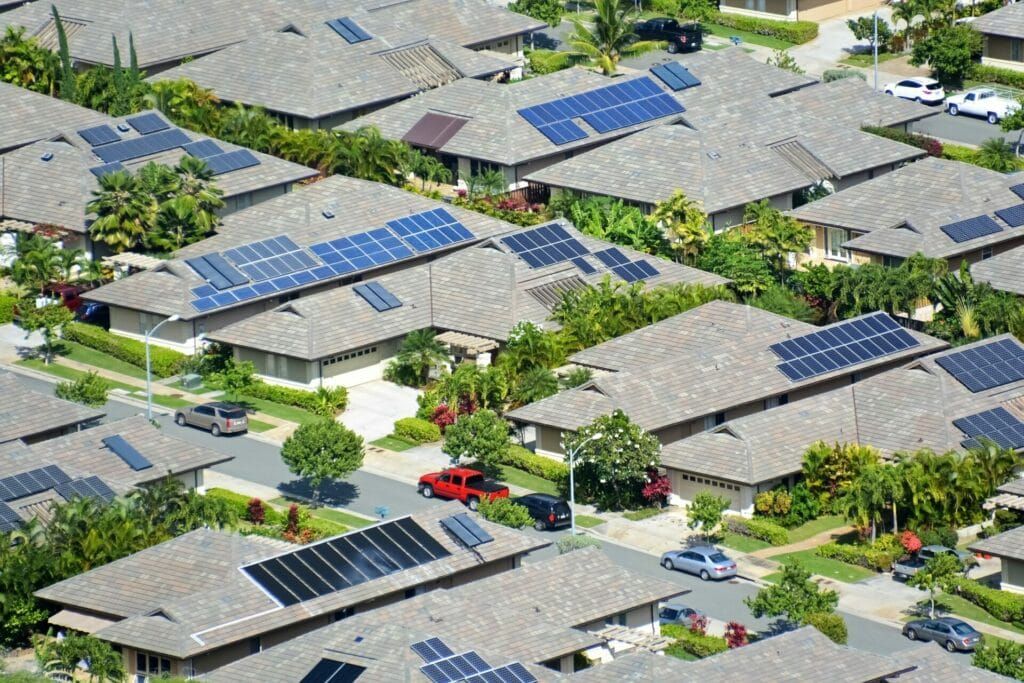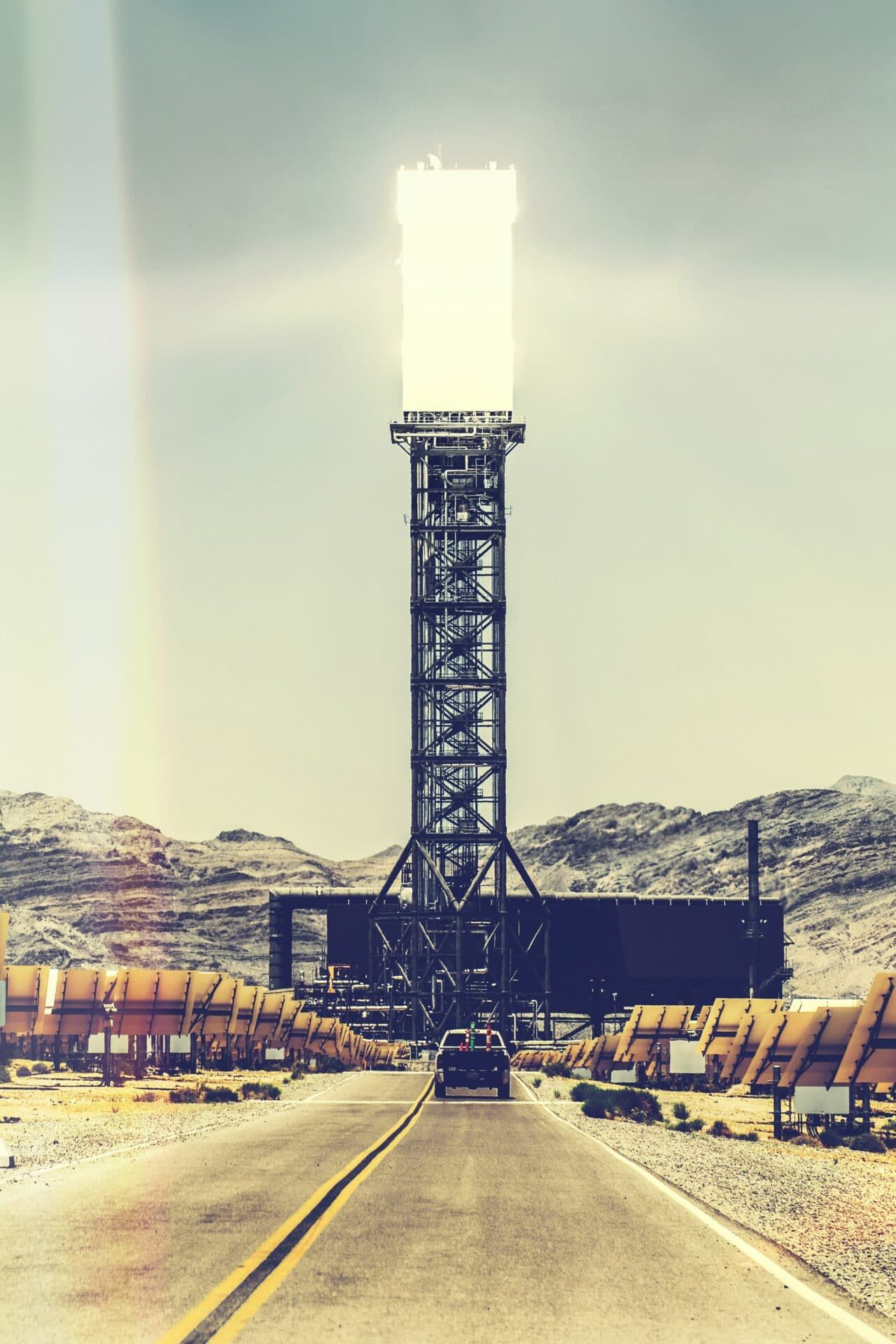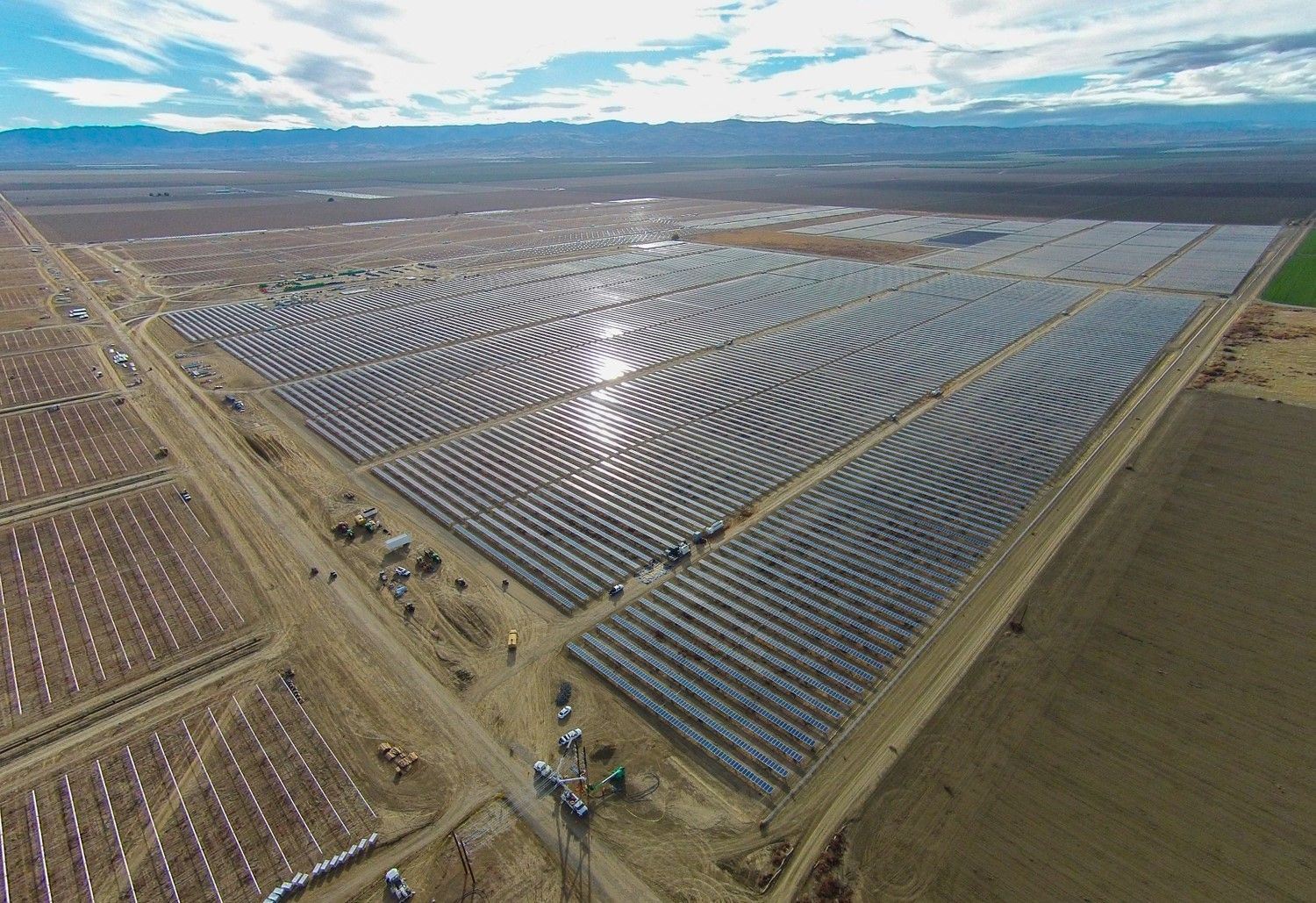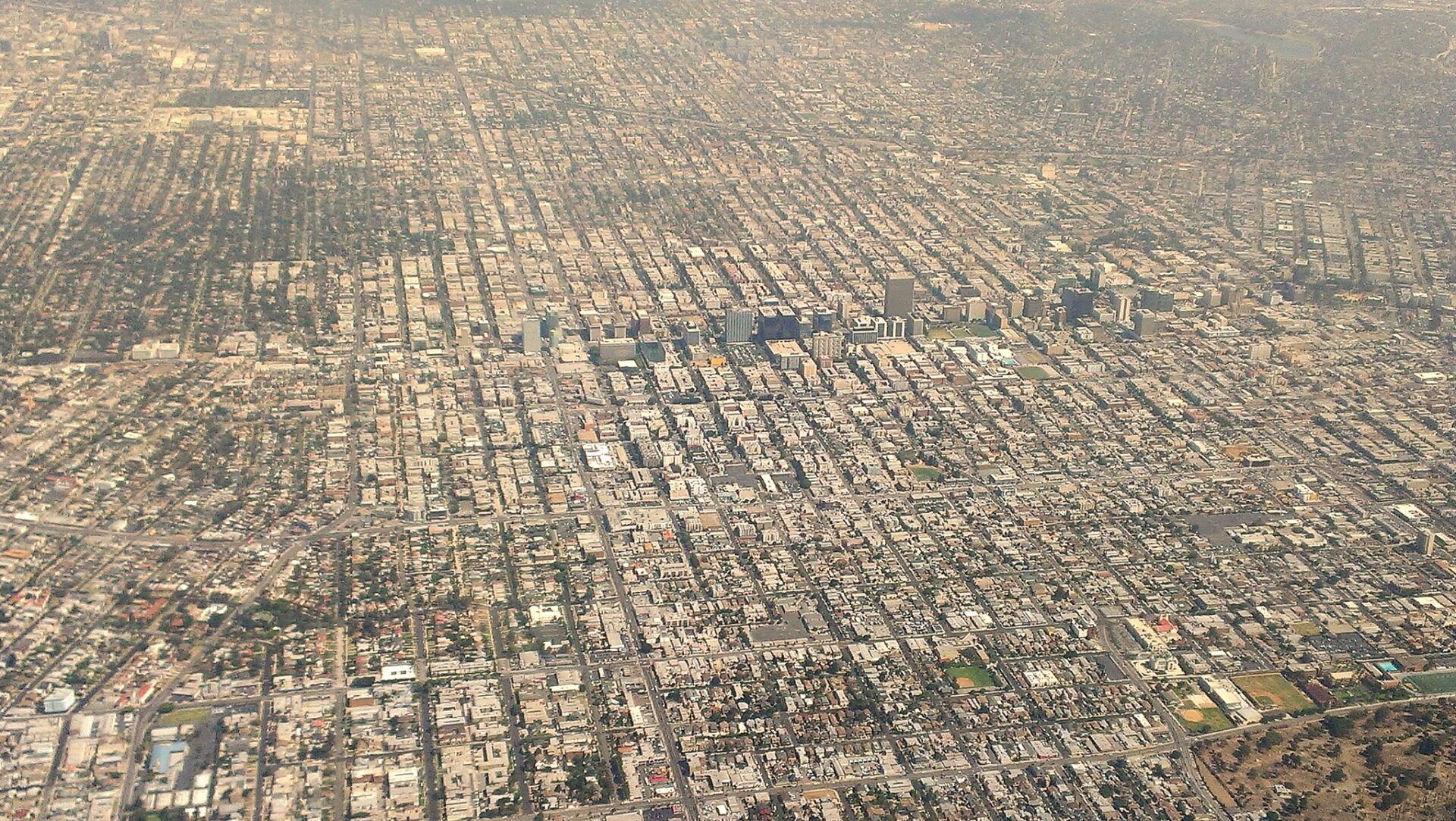Battle over solar power in the Golden State
By Dustin Mulvaney | June 3, 2022
 Rooftop solar. (Photo by Jeremy Bezanger on Unsplash)
Rooftop solar. (Photo by Jeremy Bezanger on Unsplash)
Two major fights over solar power are on the horizon in California.
The first of these is over the state’s net metering law, which incentivizes behind-the-meter rooftop photovoltaics—solar panels—on residential households, commercial buildings, and over parking lots. As more and more Californians go solar, investor-owned utilities have seen revenues fall along with electricity demand. Now the California Public Utility Commission wants to rewrite the terms for not only future but existing net metering customers, arguing that net metering customers are unfairly compensated and subsidized by other ratepayers. Critics of that proposal, released at the end of last year, say cutting payments to customers with solar by as much as 80 percent would severely undermine the economic and climate benefits of rooftop solar, like jobs and tax revenue, greater resilience in face of wildfires and blackouts, and faster pathways to shutting down polluting coastal gas power plants.
The other battle is over where to site utility-scale solar farms, particularly on public lands managed by the Bureau of Land Management, a federal agency of the Department of the Interior. Utility-scale solar on public lands are the most environmentally-damaging of the many types of lands where solar projects are proposed and built. Public lands across the American West—not just in California but in Arizona and Nevada, too—are often of high conservation value because they provide extensive undeveloped habitat for endangered, threatened, and special status species, like desert tortoise, sage grouse, kit fox, bighorn sheep, and pronghorn antelope. Utility-scale solar projects can be five to ten square miles or more and are generally fenced in, fragmenting habitat and preventing animals from coming and going with ease. To prepare the sites for construction, large machines called graders scrape off the topsoil and cryptobiotic crusts, that latter of which fixes carbon and nitrogen in the soil and helps prevent erosion. But utility-scale solar appears cheaper, especially since the price paid by utilities does not include transmission lines, which can be further marked up and sold to utility-ratepayers, so is preferred by investor-owner utilities.
There is the dilemma for California. Somehow the state must balance delivery of reliable electricity to its customers—who already pay some of the most expensive electricity rates in the country—with its habitat protection and conservation goals. The state has pledged to conserve 30 percent of its land and waters by 2030. There are species and habitat to protect, and cultural resources to steward. These seemingly unrelated conflicts represent a critical failure to bridge two of California’s major crises: climate change and biodiversity loss. Unfortunately, the incentives for putting solar in better places—whether that’s net metered distributed energy or building utility-scale solar on already-disturbed lands—are not in place.

Public lands grab and desert landscapes as climate sacrifice zones. In 2005, the Bureau of Land Management opened 22.5 million acres of public lands, first come, first served, to solar development. It was initiated by a policy mandating the development of 10 gigawatts of renewables on public lands. Soon speculators of all types—power plant developers, vertically-integrated start-ups, out-of-state electric utilities, even major financial powerhouses like Goldman Sachs—were sitting on 80 percent or so of the acres seeking right-of-way permits to develop solar projects on public lands. The lack of a planning framework led to proposals on lands donated to the Bureau of Land Management for conservation in perpetuity by the Wildlands Conservancy. Other projects were planned on proposed Areas of Critical Environmental Concern, lands that today are in National Monuments, and millions of acres of projects were slated for high-quality habitat for the federally threatened Mojave Desert tortoise, the species most impacted by the growth of solar on public lands. At the time, the number of acres with right-of-way applications was more than all the land leased to oil, gas, coal, and hard rock mining industries since 1872.
The 2009 American Recovery and Reinvestment Act invested in projects on public lands because they could be fast-tracked through environmental review. Even so, the majority of these projects were never developed; many applications for locations without transmission access, or by companies without any development capacity or technology, were eventually withdrawn. But the projects that were developed came with a considerable environmental cost.
Utility-scale solar projects built on public lands transformed the Ivanpah Valley, Chuckwalla Valley, and western Mojave Desert into industrial zones, reducing habitat for the desert tortoise, flat-tailed horned lizard, fringe-toed lizard, bighorn sheep, pronghorn antelope, and Mohave ground squirrel. Other projects damaged cultural resources, including cremation sites and geoglyphs, adding to the long history of failing to obtain consent from Tribes in the region for land use development.
After the wave of applications crested in 2010, new utility-scale proposals sought less controversial, mostly agricultural lands. Renewables development continued, but development on public lands slowed. The federal government was working on the Western Solar Plan, adopted in 2014, which established Solar Energy Zones, purportedly lower-conflict public lands where projects would receive expedited environmental and cultural resource review. But even with the Western Solar Plan framework, and subsequent Wind and Solar Rule, developers stopped proposing projects on public lands.
In 2019, right-of-way applications seeking permits to develop public lands started to tick up again. One driving factor was the Energy Act of 2020, signed into law by former President Trump, which increased the renewables mandate on public lands to 25 gigawatts by 2025. The Bureau of Land Management also lowered rates to lease public lands for solar and wind. The agency also reduced requirements that developers acquire or restore land elsewhere to make up for habitat lost with the renewables project. Another land rush was on.
In 2020, California’s Fish and Game Commission granted the iconic Joshua Tree temporary endangered species status, but at the same time permitted 15 utility-scale projects to cut down thousands of Joshua trees, including over 4,000 on the Aratina Solar Center near Boron, California. Ecological and cultural resource impacts were not limited to the California, a state that has always been heavily reliant on electricity imports. Yellow Pine Solar, a 3,000-acre (4.6 square mile) project on the California border in Nevada, will sell power to Silicon Valley and California’s Central Coast. That project resulted in the translocation of 88 desert tortoises during a drought year; a third of the tortoises were eaten by badgers within months.
The proposed GreenLink West transmission line will connect Las Vegas to Reno, Nevada, and will open up more opportunities for solar developers, with 240 square miles of solar projects already proposed along its route. The lack of consideration for land use is causing energy to sprawl over the deserts of the American Southwest, putting habitat of some species directly at risk from development. The Hopi Tribe says that the proposed line will “potentially impact paleontological resources, cultural resources, visual resources, wildlife movements, invasive species populations, natural sound-scapes, and visitor access” inside of Tule Springs Fossil Beds National Monument. The environmental conservation group Basin and Range Watch points out that transmission lines will cross priority sage grouse habitat, which is disappearing at a rate of about 1.3 million acres per year in the Great Basin. Energy sprawl can also change the dynamics of ecosystems, for example ravens use human structures to prey on baby desert tortoises, and the Defenders of Wildlife have documented a 700 percent increase in ravens in the Mojave Desert in the past 25 years.
Transmission infrastructure has direct impacts but also opens up undisturbed land for more development. These impacts could be minimized if utilities and developers could site or even bury transmission lines along highway or rail corridors, or upgrade existing transmission lines that already move power up to places that need it. Better siting—coupled with a greater emphasis on bringing power closer to the places that use it and better integration of solar power into the built environment—could go a long way to helping curb climate pollution and conserve ecosystems.

Distributed energy resources, equity, and avoided environmental impact. Distributed energy resources refer most commonly to photovoltaics and energy storage that are found behind-the-meter, like rooftop solar. These projects are generally more expensive than utility-scale power because each project is unique, local permitting costs are greater relative to the size of the project, and they do not benefit from economies of scale as much as big utility-scale projects do.
There are ways to offset those costs. Most distributed energy resources are compensated through an arrangement known as net metering. The idea is that a rooftop solar system exports excess power to the grid during the daytime and then pulls power off the grid at night. As long as exports to the grid are equal to imports, then the “net” electricity use is zero. When customers are compensated at the retail rate, this means the costs of electricity for these customers can be zero. (Unlike feed-in-tariffs used in many parts of the world to compensate customers with solar panels, net metering does not allow compensation if a customer delivers more electricity to the grid with their solar panels than they use, though lifting this requirement was suggested by some groups in the net metering reforms). As more rooftop customers are added to the system, the number of customers utilities can charge for energy falls, leading to a revenue shortfall. Big utilities need to find other ways to recoup operation costs—and their return on investment for shareholders.
In December 2021, the California Public Utilities Commission proposed new rules for net metering that would cut the value of solar by up to 80 percent. New customers would have to pay a grid access charge of $8 per kilowatts of solar installed. For an average system size of five and a half to seven kilowatts across the state’s utilities, that would add up to $44 – 56 per month. Their contributions to the grid would also be compensated at a lower rate, as low as $0.04 per kilowatt-hour. Existing customers would have their contracts torn up and replaced with this new compensation package on a so-called “glide path” over a few years to ease the change in billing. Opponents of the California Public Utilities Commission proposal call this a “solar tax” and say it would be the largest such penalty for rooftop solar in the country. Organizations like Vote Solar and the California Solar and Storage Association say the proposal could cost the state thousands of solar installation and sales jobs. This will inevitably disrupt rooftop solar deployments as the time it takes for a customer buying solar panels to pay off their investment will increase to 12 to 15 years for most solar customers and 18 years for low-income customers. This situation could even force the California Energy Commission to reconsider its rooftop solar mandate that requires all new home construction to be equipped with solar, as it may no longer be considered a cost effective measure. Analysts at Wood Mackenzie suggest that rooftop solar deployments would drop by 50 percent by 2024 with the proposed CPUC net metering policy.
Utilities and The Utility Reform Network, an organization focused on lowering utility bills, have argued that solar customers cost-shift the burden onto other ratepayers, primarily low-income customers. This is an important equity issue. On the other hand, most environmental justice groups in California have been supportive of net metering including the California Environmental Justice Alliance, Asian Pacific Environmental Network, the Greenlining Institute, the Environmental Health Coalition, and Communities for a Better Environment. These groups emphasize the importance of community ownership, resilience, local jobs, and affordability, and proposed to keep the net metering policy as is with further investments in these communities.
There are several factors to consider with regard to solar equity. First, low-income customers often find the cost of solar to be cost-prohibitive or not feasible because they are renters. Where they are homeowners, one reason solar looks expensive to low-income customers is that they pay a 30-35 percent lower rate due to the public utilities code that requires this discount; this can make solar hard to pencil out. While California has subsidies to help low-income customers install solar, these programs regularly run out of funds. Second, the social cost-shift of air pollution exposure to fenceline communities is not considered. Building large utility-scale projects far away does not directly address communities exposed to pollution from California’s aging and polluting natural gas plants. Accelerating the adoption of rooftop and canopy solar and storage could lead to earlier closures of these polluting power plants, which are often running to ensure there are adequate electricity supplies. In May 2022, California’s governor’s office announced $5.2 billion to support back up diesel generators and natural gas power plants needed for reliability. The current configuration of California’s renewable energy portfolio requires a dirty fossil fueled shadow grid.
California finds itself in this awkward position of incentivizing utility-scale infrastructure that results in environmental degradation, while disincentivizing distributed resources that have little to no impact on land or wildlife.
Centralized infrastructure is also more vulnerable to natural disasters such as earthquakes, wind storms, and wildfire, the latter two of which are increasing in likelihood and severity due to climate change. California meets 20 to 30 percent of its electricity load by buying power from Nevada, Arizona, Washington, Oregon, and Utah. As the state grapples with wildfire mitigation strategies such as shutting off transmission lines during high winds in the dry season, distributed energy resources are one means to keep the lights on. The California Public Utilities Commission fails to account for these benefits when assessing the costs of and values provided by centralized versus distributed solar.
Distributed solar can advance public health by avoiding air pollution where fossil fueled power plants are located near to urban populations, offer land use benefits including avoided carbon debts caused by land use change, and promote reliability and resiliency improvements from local deployment. A study by Vibrant Clean Energy that valued some of these benefits in a very high resolution model of the electricity system found that across the United States, a grid heavily invested in distributed energy resources would be $473 billion cheaper than one that one reliant on utility-scale renewables and storage. Maximizing the value of distributed energy means minimizing investment in transmission and distribution; time and time again California’s Independent System Operator who manages the grid, has canceled billions of dollars in transmission projects deemed no longer necessary because of local upgrades and distributed energy resources. Further opportunities for distributed energy resources will be enabled by new technologies that aggregate rooftop solar, energy storage, and other resources into virtual power plants as suggested by the head of the Department of Energy’s loan program.

A more resilient solar landscape. California has ample opportunity to direct policy to encourage better siting of solar projects. Rooftops and solar canopies in the built environment can help displace some of the impacts from utility-scale solar projects. The California Energy Commission estimates that the state needs 40 gigawatts of distributed solar to meet its 2045 clean energy goals for electricity. The City of Los Angeles alone has 200 square miles of surface parking lots. But current trends in utility-scale build out and the proposed net metering decision promise to erode some of these deployments, which would result in an over-sized utility-scale sector that does not offer resilience to land or electricity supply.
California does need land for solar projects, but it doesn’t have to be undeveloped habitat important to meet its conservation goals. The EPA has identified tens of thousands of square miles of hazardous waste sites and abandoned landfill and mines that would be appropriate for solar. California also has nearly 11,500 square miles of selenium-contaminated lands no longer good for agriculture, and nearly 4,000 mile long canal system that could be covered with solar panels while simultaneously reducing evaporation of its water supply—a critical co-benefit that could help during its regular multi-year droughts. The state could use conservation funds to ensure utility-scale interconnection to these sites would be cost-competitive by bridging the cost between greenfield sites and disturbed sites. Our research found utility-scale projects on disturbed lands can be built three times as fast, with significantly lower mitigation costs (mitigation lands often need to be acquired and managed to compensate for lost habitat from a project).
The case of solar in California shows that efforts to protect the region’s biodiversity and climate cannot be done in isolation. The independent science advisers to the California Desert Renewable Energy Conservation Plan in 2010 advised to proceed with caution when siting renewable energy in landscapes rich in biodiversity and cultural resources. Specifically, they said “We also strongly advocate using “no regrets” strategies in the near term— such as siting developments in already disturbed areas—as more refined analyses become available to guide more difficult decisions.” Unfortunately, state policy makers and planners are only listening to climate scientists, when it should be heeding the warning from the ecosystem and land use scientists as well. Land use change and conservation ultimately affects the climate after all.
It is time to get solar right in the Golden State. Doing so will require that future utility-scale solar projects be directed to land that has already been degraded, and that rooftop solar be funded in a way that expands its use but does not hurt the poor or drive utilities out of business. Such policies are achievable and will help California meet its climate and conservation goals at the same time.
Together, we make the world safer.
The Bulletin elevates expert voices above the noise. But as an independent nonprofit organization, our operations depend on the support of readers like you. Help us continue to deliver quality journalism that holds leaders accountable. Your support of our work at any level is important. In return, we promise our coverage will be understandable, influential, vigilant, solution-oriented, and fair-minded. Together we can make a difference.
Keywords: California, clean energy transition, climate crisis, energy access, energy transition, renewable energy, solar, solar energy, solar power
Topics: Climate Change
















Another money grab by a for profit utility.
While there can be problems with siting utility scale projects on public land, if we don’t get climate change under control, the natural world will be significantly degraded to the point where this discussion becomes moot.
Well, I agree the utilities ARE up for money grabs. BUT why waste all that space when it could be used for solar panels. Putting solar farms into wildlife habitat does more damage than is necessary. There are all these parking ramps, rooftops etc in the urban areas that could be put to good use. Yes make sure the utilities are NOT getting the most benefit at taxpayers expense.
It is no secret that the cost of electricity does not become lower every year. , so the transition to solar energy is not a long shot. The issue of installing solar energy without harming people and avoiding impact on the environment is an acute question. Regarding the placement of solar power plants, Investors see prospects in the construction of solar power plants on the roof. There are many reasons for this. Energy consumption occurs at the place of its production, which reduces losses. In addition, for rooftop stations, the “green” tariff is higher compared to ground stations, and the… Read more »